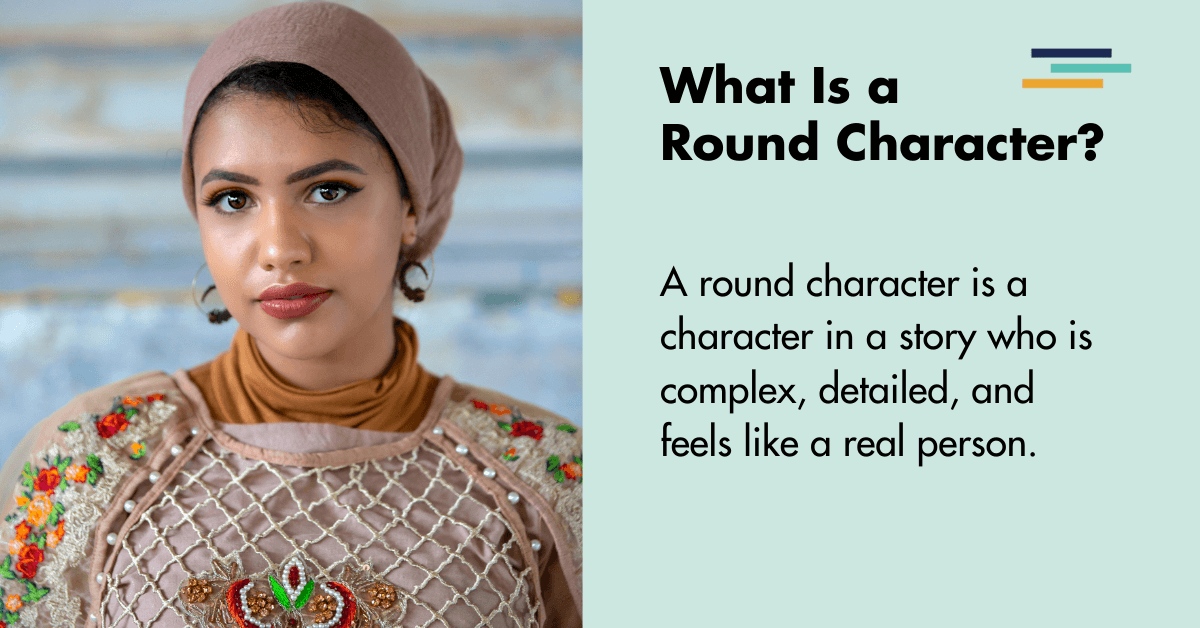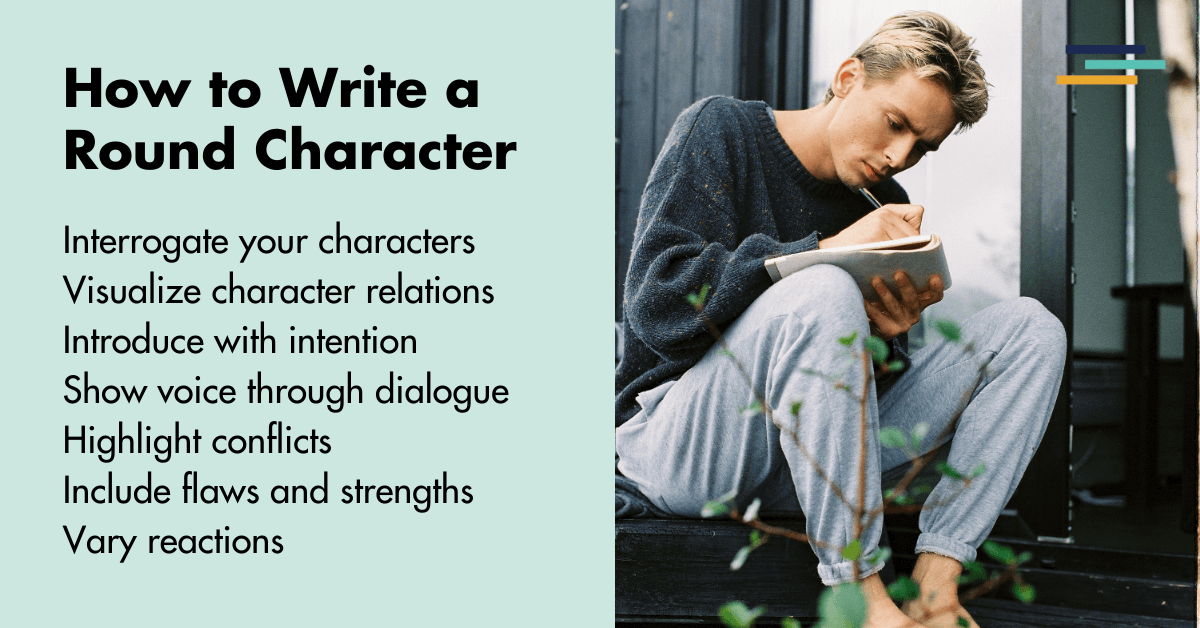
Like most writers, I love to associate things with their binary opposites. It makes it easier to understand most terms. Easier, but not a slam dunk.
Some terms have more than one opposite. Take the word round, for instance. One of its opposites is angular. That won’t help us with the topic at hand. Neither will top-of-mind opposites of flat, raised, elevated, textured, and bumpy.
Our focus is on the characters in our stories and the question of whether they are simple and one-dimensional (flat) or complex and well developed (round).
Read on to find out what round and flat characters are, how they can be used in a story, examples from well-known books, plus some writing tips.

What Is a Round Character?
A round character is a character in a story who is complex, detailed, and feels like a real person.
Round characters in a story seem like real people. They have names and histories. You can describe them using information you would gather with your senses when you’re in their presence. They have hobbies and jobs, and they own stuff. They also have relatives and friends.
Round characters in a story possess other attributes as well. These include how they deal with others, and their emotional state; their weaknesses and flaws; their abilities and talents; their passions and fears. These internal matters add up to their personality and show in their voice.
As events in a story unfold, round characters act and react in accord with their goals and motives. But they also evolve and adapt, especially in the face of conflict and danger. For instance, a protagonist who starts off shy and insecure becomes confident and brave by the end of the story.
Round characters in a story seem so real, you can compare them to the actual people you know, either personally or through the media.
What is a Flat Character?
A flat character is a character in a story who is simple and not very detailed.
Flat characters in a story usually have one or two main traits and don’t change or develop much throughout the story. They are more straightforward and lack depth. These characters tend to stay the same throughout a story. They serve a specific purpose, like moving the plot forward or supporting the main characters, without much personal growth. For instance, a sidekick, as a flat character, might remain cheerful and optimistic but never change or reveal more about themselves.

Round vs Flat Character Examples
My first example of a round character is Flat Stanley. Ironic, isn’t it?
Flat Stanley is a character from a popular children’s book series created by Jeff Brown. The original book, titled Flat Stanley, was published in 1964. In the story, Stanley Lambchop is a young boy who is accidentally flattened when a bulletin board falls on him while he’s sleeping.
Instead of being hurt, Stanley becomes as flat as a piece of paper, which leads to some interesting adventures. For example, he can slide under doors, be flown like a kite, and even be mailed in an envelope to visit friends in distant places.
Flat Stanley may be flat physically, but as a character he’s round. He remains cheerful and adaptable. Instead of complaining, Stanley uses his flatness to embark on unique adventures, like traveling through the mail and helping catch thieves. He embodies resilience.
As a round character, Stanley is relatable and inspiring for young readers, handling what comes his way with a sense of humor and bravery. To young readers who feel they are different as well, Flat Stanley stands as a hero. Like him, they too can ooze with creativity and face down obstacles.
Jeff Brown also wrote a few flat characters into the Flat Stanley story. In chapter two, Stanley’s mother drops her favorite ring through a grate in the sidewalk. Because he is flat, literally, Stanley slips through one of the grate’s narrow openings to retrieve the ring.
Meanwhile, two policemen come along. Brown offers no details at all about their physical appearances; and only a hint about their personalities. He gives them very few lines of dialogue, only two, in fact, the bare minimum the plot requires.
In the first line, Brown names one of the policemen. Though it’s true that naming a character often raises reader expectations about that character’s importance (more on this later); in this case, the name Brown gives is generic—so generic, that it does the opposite and underscores the character as flat.
The second line of dialogue underscores the same. Brown tags it with “they said,” not “he said;” which further diminishes any expectation of their playing larger, more round, roles in the story as it unfolds.
More Round Character Examples
Three authors known for creating well-rounded, complex characters in their works are Charles Dickens, Jane Austen, and Dorothy Gilman.
- Charles Dickens: His novels, like Great Expectations and David Copperfield, are filled with detailed and multifaceted characters who often undergo significant personal growth.
One of Charles Dickens’ most rounded characters is Pip in Great Expectations.
Pip begins as an innocent and humble orphan raised by his sister and her husband. But his character changes throughout the story. He comes into wealth and social status. His desires and insecurities come to the fore and are portrayed vividly; as are his moral struggles as well.
Pip becomes ashamed of his humble origins and the people who cared for him—people like Joe Gargery. Pip’s shame uncovers the intense internal conflict he faces between his desires and his true self.
Pip’s journey through the story shows the personal growth typical of round characters. By the end, he starts to understand that his ambitions are shallow, and that his pursuit of wealth and social standing has left him feeling empty. He becomes more self-aware, compassionate, and grounded. He transforms from a naïve boy into a more mature and empathetic adult. This complexity makes Pip a round character.
- Jane Austen: In books like Pride and Prejudice and Emma, Austen’s characters are known for their depth, wit, and development throughout the story.
Emma Woodhouse serves as one of Jane Austen’s most rounded characters. Emma starts off as a rich, smart, and self-assured young lady. And she prides herself on her matchmaking abilities. However, she is also somewhat spoiled, headstrong, and blinded by her own privilege; often meddling in the lives of others with little regard for the consequences.
Emma experiences substantial growth as the story unfolds. She starts out well-intentioned; but, in the end, she is forced to confront her flaws and the limitations of her judgment. She slowly realizes her own vanity, as her attempts at matchmaking fail. She recoils at the hurt feelings she has caused by her impulsiveness and lack of self-awareness.
By the end, she matures into a more considerate person. With the aid of Mr. Knightly and Harriet Smith, she acknowledges her mistakes. She stops manipulating others and learns to value them instead, which brings her true happiness.
Emma’s growth and transformation as a multi-dimensional character models what it means to be a round character.
- Dorothy Gilman: In books such as The Unexpected Mrs. Pollifax, The Amazing Mrs. Pollifax, The Elusive Mrs. Pollifax, and the entire Mrs. Pollifax series (14 books).
I’m including the example of Mrs. Polllifax because she is the protagonist, not just of a standalone story, but of a 14 book series.
Mrs. Emily Pollifax is a wonderfully round character. At the start of the series, she is a widowed, retired woman in her 60s. She feels unfulfilled and longs for adventure, so she impulsively volunteers to become a spy for the CIA. The CIA welcomes her in, though she has no prior experience. Nonetheless, her surprising career change shows the many layers of her character.
Mrs. Pollifax shows courage and a striking ability to adapt through the entire series. She faces down danger and often surprises herself and others with her resourcefulness. But these are traits she grows into. At first, she was an ordinary grandmother. She transforms into a capable spy. Her sharp wit and kind, cheerful demeanor endear her to readers, while her growing confidence from book to book through the series adds depth to her personality.
As she embarks on missions around the world, Mrs. Pollifax finds new purpose and strength in her later years. Her growth in the series illustrates her complexity and makes her a richly developed character.
Examples of Flat Characters
The stories of Dickens, Austen, and Gilman contain flat characters as well.
For example, in Great Expectations, we encounter Uncle Pumblechook, Pip’s self-important relative. He remains shallow and unchanged through the story and is, therefore, flat.
The same holds true for Miss Bates in Austen’s Emma. Miss Bates is a kind and talkative character; but she stays stuck in one-dimension, defined solely by her chatter and social status. Therefore, she also is flat.
Finally, in Gilman’s Mrs. Pollifax Series, we run into Carstairs, Mrs. Pollifax’s competent and straightforward CIA boss. But that’s all there is to him. We consider him flat, because he mostly serves to advance the plot without much personal depth.

Tips for Writing Round or Flat Characters
Before I share my top tips on writing round or flat characters, I have a confession to make. I am a recovering pantser. Now, I’m a dyed-in-the-wool plotter. I started changing my approach nearly ten years ago. Then I found Fictionary.co, and The Fictionary StoryTeller app, and that sealed the deal.
The Fictionary StoryTeller app is powerful story structure software. It allows authors to track a total of 38 elements in each scene of a story. One of the 38 is Characters. Learning to be more intentional about the characters I write is one reason I changed.
So, Pantsers, beware—writing round or flat characters doesn’t just happen. These tips, combined with your intention, could change your approach as well.
7 Tips For Writing Flat and Round Characters
Interrogate Your Characters
Imagine meeting your main characters for the first time and start from there.
- What are your first impressions?
- How old are they?
- What do they look like?
- What is the color of their hair?
- How tall or short are they?
- What is their name?
- What do they sound like when they speak? Do they have an accent?
- Who do they remind you of?
- Who are their friends? Who are their enemies?
- Who are their family members?
- What is their job?
- What are their hobbies?
- Their favorite food? The food they hate the most?
- Where do they live?
- What are their background and history?
These questions pertain to what you can see and know without getting into their head and figuring out their psychology or personality type.
The next set of questions relates more to the internal.
- How does your character treat others?
- Are they kind? Are they harsh?
- What is their dominant emotional state?
- What talents or abilities do they believe they have? What are they bad at?
- What do they love or hate, or attach some other strong emotion to?
- What are their weaknesses and flaws?
- What are their fears?
Try saying at least two things in answer to each question. You might not use all of this information as you write your story, but you will have plenty to draw from to craft a round character.
Visualize Character Relationships
Characters in a story form a web of relationships with one another. Your characters are the nodes on this web. Their relationships are like the strands you spin between them.
Unlike spider webs, your web of characters might not appear as though you spun it for its visual appeal. You won’t see the amazing symmetry of strands between nodes. We don’t form character webs for that purpose. We form them to identify how characters connect to each other in terms of their roles and the themes of the story.
For example, suppose the theme of your story is the power of people loving their enemies and that the character web for your story consists of four characters: Paula (the protagonist), Alan (the antagonist), Fanny (friend 1 of protagonist), and Frank (friend 2 of protagonist).
Suppose Paula starts your story on the fence, in a neutral position, as it relates to loving her enemies. Then Alan offends her. He does something so egregious to Paula that she descends into unvarnished hatred of Alan. Thus, you can use their interaction along this strand to show Paula’s tendencies for revenge; and what a hateful response to an enemy looks like.
Suppose, however, Paula stops part way across the strand prior to taking revenge on Alan. She reverses course and heads instead across the strand to Fanny to talk things over. You can use their interaction along the strand connecting them to explore their deepest thoughts about your story’s theme.
Meanwhile, as Paula and Fanny are talking, suppose Paula’s good friend, Frank, decides to take revenge on her behalf. The strand between Frank and Alan becomes yet another opportunity for your story. In this case, you can show what hatred and revenge look like when someone believes they are coming to the defense of a friend.
I could keep this going, but I think you get the point. The web of relationships among your characters provides opportunities to explore their connections; not just to the protagonist, but to each other, to their inner selves, and to how they relate on the inside to the themes of your story. Opportunities, in other words, to create round characters.
Introduce Characters As Round or Flat
Start by listing the characters in each scene of your story. (The Fictionary StoryTeller app creates this list for you.) Categorize each character on the list by whether you intended them to be round or flat. Hint: If a character appears in three or fewer scenes of your story, it might be best to consider them flat.
Next, look at the scenes where you introduce each character. If you intend for a character to be flat, limit the amount of information you use to introduce them. They might not even require a name. Names add roundness to characters. Keep this mind, if you’re attempting to limit how round you want a particular character to feel.
As you introduce round characters, don’t share everything you know about them in their first scene. Share enough information to create a physical image of them in the minds of readers.
Add to the information as the story moves forward. This will make readers feel like they’re getting to know your round characters in the same way they get to know real people.
One bit of further advice on this; the timing of your sharing additional information about your round characters is as important as the amount of information you share. Only roll out the details that move the story forward. For instance, if your character prefers not to dress in black, but that has nothing to do with the plot or the scene where you’re thinking of mentioning it, don’t include it.
Show Round and Flat Characters’ Voices Through Dialogue
A character’s voice includes the sounds they make when they speak, but there’s more. A character’s voice also represents how they put their thoughts together, how fast or how slow they speak, and the words they use or don’t use. When well crafted, readers will recognize the voice of a character in a story. They will sense whether a character’s speech sounds like them or not.
Hint: The eight most influential factors in a round character’s voice are age, regional accent, education, physical size, vocal characteristics, personality, emotional state, and personal habits or quirks. The voices of flat characters need not reflect all eight influences.
Highlight Conflicts to Reveal Character Complexity
Show the challenges they face, and their inner dilemmas, such as moral choices, fears, desires, or past traumas. Create tension in their relationships. Force them to make decisions that test their ethics or beliefs.
Or place them in other types of challenging situations where they must face external obstacles and rise to the occasion; or not. These will show their motivations, their strengths and weaknesses, and where they are vulnerable.
Include Flaws and Strengths
Make your characters more relatable by giving them a mix of strengths to admire and weaknesses that make them vulnerable.
Vary Reactions and Show Growth
Have your characters respond differently to various situations, demonstrating their emotional range and adaptability.
Allow your characters to evolve over the course of the story, learning from experiences and making choices that reflect their personal journey.
Final Word of Encouragement
Do you have a character you desire to craft as round, like Flat Stanley? Or Pip, or Emma, or Mrs. Pollifax? Never fear, you can do it! The reward is characters that will feel real to your readers; characters they will remember.


